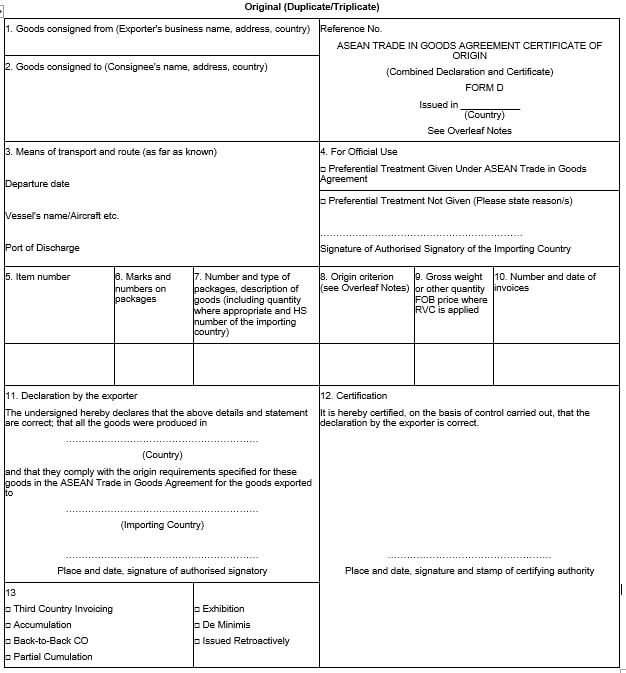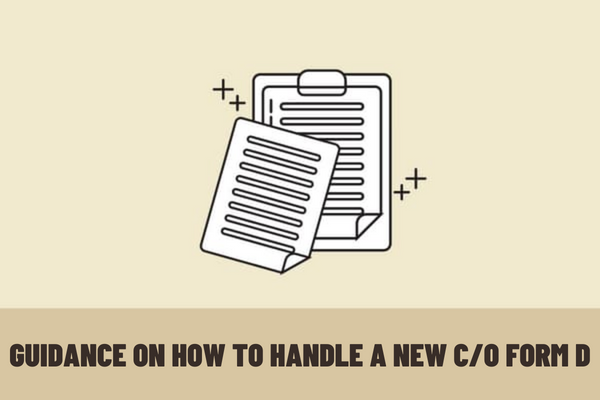How does the General Department of Vietnam Customs guide the handling of the new C/O form D in case there is a difference in the format?
How does the General Department of Vietnam Customs guide the handling of the new C/O form D in case there is a difference in the format?
Most recently, the General Department of Vietnam Customs issued Official Dispatch 4832/TCHQ-GSQL in 2022 answering the problem of C/O form D when there is a difference in the format as follows:
Official Dispatch 4832/TCHQ-GSQL in 2022 states the following issues:
The General Department of Vietnam Customs guides the Customs Departments of provinces and cities to apply C/O form D issued from November 1, 2022 as follows:
- For C/O issued on the national single-window system/ C/O using an electronic signature with a lookup website of the issuing agency: In case there is a difference in C/O format compared with the new form C/O format specified in Circular No. 10/2022/TT-BCT of Vietnam dated June 1, 2022, does not affect the validity of the C/O. Checking the validity of the C/O shall comply with current regulations.
- For manual C/O (with hand signature and ink seal): Request Customs Departments of provinces and cities to follow the instructions in Official Dispatch 1683/TCHQ-GSQL in 2022. If any problems arise, please report them to the General Department of Vietnam Customs (Department of Supervision and Management) for guidance.
Thus, when there is a difference in form:
For C/O issued on the national single-window system/ C/O using an electronic signature with a lookup website of the issuing agency, if it does not affect the validity of the C/O. Checking the validity of the C/O shall comply with current regulations.
As for the manual C/O (with hand-signed and ink-seal) the following shall be done:
- For C/O issued during the transition period from May 1, 2022 to the end of October 31, 2022, the customs authority shall accept the old C/O form D (specified in Circular No. 19/2020/TT-BCT) and new C/O form D.
- For C/O form D issued from November 1, 2022, the customs authority shall only accept C/O form D issued under the new form.

How does the General Department of Vietnam Customs guide the handling of the new C/O form D in case there is a difference in the format?
What are the regulations on C/O form D?
Pursuant to Article 7 of Annex I enclosed with Circular 10/2022/TT-BCT of Vietnam on C/O form D as follows:
- C/O Form D must be in the English language and on A4 size white paper in conformity with the specimen shown in Annex II enclosed herewith.
- A C/O shall comprise one original and two copies.
- Each C/O shall bear a reference number separately given by each C/O issuing authority.
- Each C/O shall bear the authorized signature and official seal of the C/O issuing authority. Such signature and seal may be applied manually or electronically. A Member State may accept the electronically executed signature and seal in accordance with its domestic regulations.
- The original copy of the C/O shall be forwarded by the exporter to the importer for submission to the customs authority of the importing Member State at the port or place of importation. The duplicate shall be retained by the C/O issuing authority in the exporting Member State. The triplicate shall be retained by the exporter.
How is the new C/O form D issued?
Currently, the C/O form D is specified in Annex II enclosed with Circular 10/2022/TT-BCT of Vietnam as follows:

OVERLEAF NOTES
1. Member States which accept this form for the purpose of preferential treatment under the ASEAN Trade in Goods Agreement (ATIGA)
BRUNEI DARUSSALAM | CAMBODIA | INDONESIA |
LAO PDR | MALAYSIA | MYANMAR |
PHILIPPINES | SINGAPORE | THAILAND |
VIETNAM |
2. CONDITIONS: The main conditions for admission to the preferential treatment under the ATIGA are that goods sent to any Member States listed above must:
(i) fall within a description of products eligible for concessions in the country of destination;
(ii) comply with the consignment conditions in accordance with Article 32 (Direct Consignment) of the ATIGA; and
(iii) comply with the origin criteria set out in Chapter 3 of the ATIGA.
3. ORIGIN CRITERIA: For goods that meet the origin criteria, the exporter and/or producer must indicate in Box 8 of this Form, the origin criteria met, in the manner shown in the following table:

4. EACH ARTICLE MUST QUALIFY: It should be noted that all the goods in a consignment must quality separately in their own right. This is of particular relevance when similar articles of different sizes or spare parts are sent.
5. DESCRIPTION OF PRODUCTS: The description of products must be sufficiently detailed to enable the products to be identified by the Customs Officers examining them. Name of manufacturer and any trade mark shall also be specified.
6. HARMONISED SYSTEM NUMBER: The Harmonised System number shall be that of in ASEAN Harmonised Tariff Nomenclature (AHTN) Code of the importing Member State.
7. EXPORTER: The term “Exporter” in Box 11 may include the manufacturer or the producer.
8. FOR OFFICIAL USE: The Customs Authority of the importing Member State must indicate (√) in the relevant boxes in column 4 whether or not preferential treatment is accorded.
9. MULTIPLE ITEMS: For multiple items declared in the same Form D, if preferential treatment is not granted to any of the items, the “Preferential Treatment Not Given” in Box 4 should be ticked (√) and the item number should also be circled or marked appropriately in Box 5.
10. FOB PRICE: This is applicable for goods exported from and imported by Kingdom of Cambodia, Republic of Indonesia, and Lao People's Democratic Republic and where the Regional Value Content (RVC) criteria is applied, by providing the FOB price of the goods in Box 9.
11. THIRD COUNTRY INVOICING: In cases where invoices are issued by a third country, "the Third Country Invoicing" box should be ticked (√) and such information as name and country of the company issuing the invoice shall be indicated in box 7.
12. BACK-TO-BACK CERTIFICATE OF ORIGIN: In cases of Back-to-Back CO, in accordance with Rule 11 (Back-to-Back CO) of Annex 8 of the ATIGA, the "Back-to-Back CO" box should be ticked (√) and the reference number and the date of issuance of the original Proof(s) of Origin shall be indicated in Box 7.
13. EXHIBITIONS: In cases where goods are sent from the exporting Member State for exhibition in another country and sold during or after the exhibition for importation into a Member State, in accordance with Rule 22 of Annex 8 of the ATIGA, the “Exhibitions" box should be ticked (√) and the name and address of the exhibition indicated in Box 2.
14. ISSUED RETROACTIVELY: Due to involuntary errors or omissions or other valid causes, the Certificate of Origin (Form D) may be issued retroactively, in accordance with paragraph 2 of Rule 10 of Annex 8 of the ATIGA, the “Issued Retroactively” box should be ticked (√).
15. ACCUMULATION: In cases where goods originating in a Member State are used in another Member State as materials for finished goods, in accordance with paragraph 1 of Article 30 of the ATIGA, the “Accumulation” box should be ticked (√).
16. PARTIAL CUMULATION (PC): lf the Regional Value Content of the material is less than forty percent (40%), the Certificate of Origin (Form D) may be issued for cumulation purposes, in accordance with paragraph 2 of Article 30 of the ATIGA, the “Partial Cumulation” box should be ticked (√).
17. DE MINIMIS: lf a good that does not undergo the required change in tariff classification does not exceed ten percent (10%) of the FOB price, in accordance with Article 33 of the ATIGA, the “De Minimis” box should be ticked (√).
LawNet
